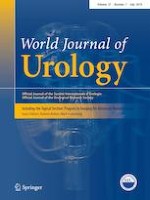01-07-2019 | Original Article
Perioperative and long-term results of retroperitoneal laparoscopic pyelolithotomy versus percutaneous nephrolithotomy for staghorn calculi: a single-center randomized controlled trial
Published in: World Journal of Urology | Issue 7/2019
Login to get accessAbstract
Purpose
To compare the perioperative and long-term outcomes of retroperitoneal laparoscopic pyelolithotomy (RLP) and percutaneous nephrolithotomy (PCNL) for the treatment of staghorn calculi.
Methods
From May 2011 to March 2017, eligible patients with staghorn calculi were randomly assigned to two groups: RLP and PCNL. Patients underwent the operations prospectively. Subsequently, a follow-up protocol was performed. Perioperative data related to the efficacy, safety and long-term outcomes (stone recurrence and functional changes in the affected kidney) were comparatively analyzed between the two groups.
Results
Overall, 105 patients underwent surgical treatment, including 51 in the RLP group and 54 in the PCNL group. There was no difference in demographics or stone characteristics between the two groups. The single-session stone-free rate (SFR) was higher (88.2% vs. 64.8%), the mean hemoglobin drop was lower (0.4 ± 0.3 vs. 1.7 ± 0.9 g/dL), the rate of postoperative fever was lower (5.9% vs. 20.4%), but operative time was longer (135.7 ± 35.5 vs. 101.9 ± 41.2 min) and the total cost was more expensive (5546 ± 772 vs. 3861 ± 402 USD)in the RLP group than in the PCNL group (all p < 0.05). The mean increase in the split function (8.3 ± 3.1 vs. 4.2 ± 2.4 mL/min) and the rate of improvement of the affected kidney (56.3% vs. 35.3%) were significantly higher in the RLP group than in the PCNL group at 1 year after surgery (both p < 0.05). However, the rate of stone recurrence was similar between the groups at a mean follow-up of 47.3 ± 18.6 months.
Conclusions
PCNL remains the first-line treatment for most cases of staghorn calculi. Nevertheless, in some selected cases with the extrarenal and dilated pelvis, RLP can be considered as an alternative management of staghorn calculi, which was associated with a high single-session SFR, low rates of complications, and better functional preservation of the affected kidney.





